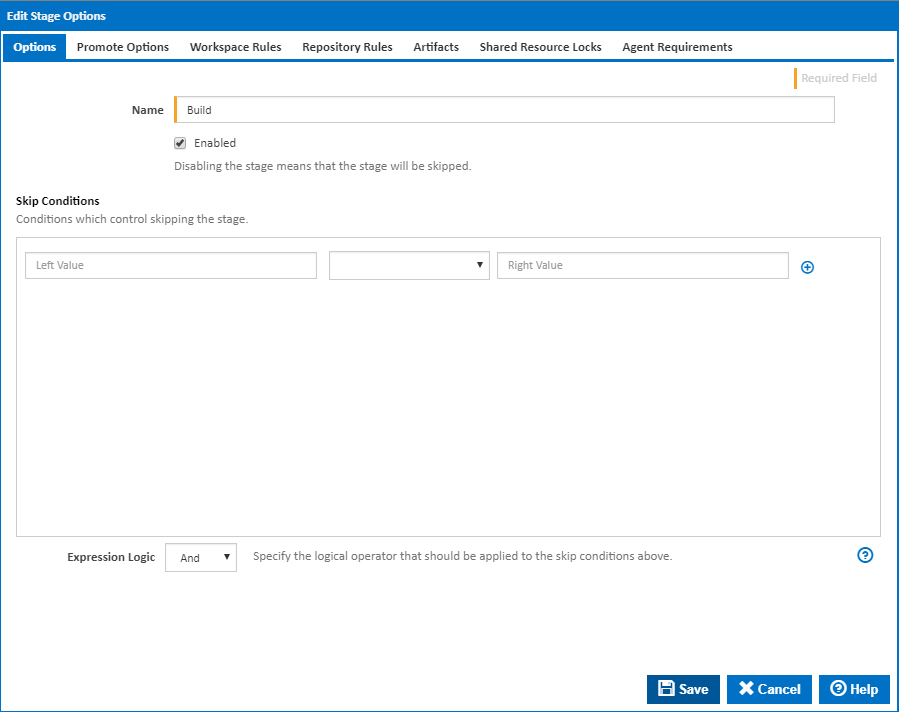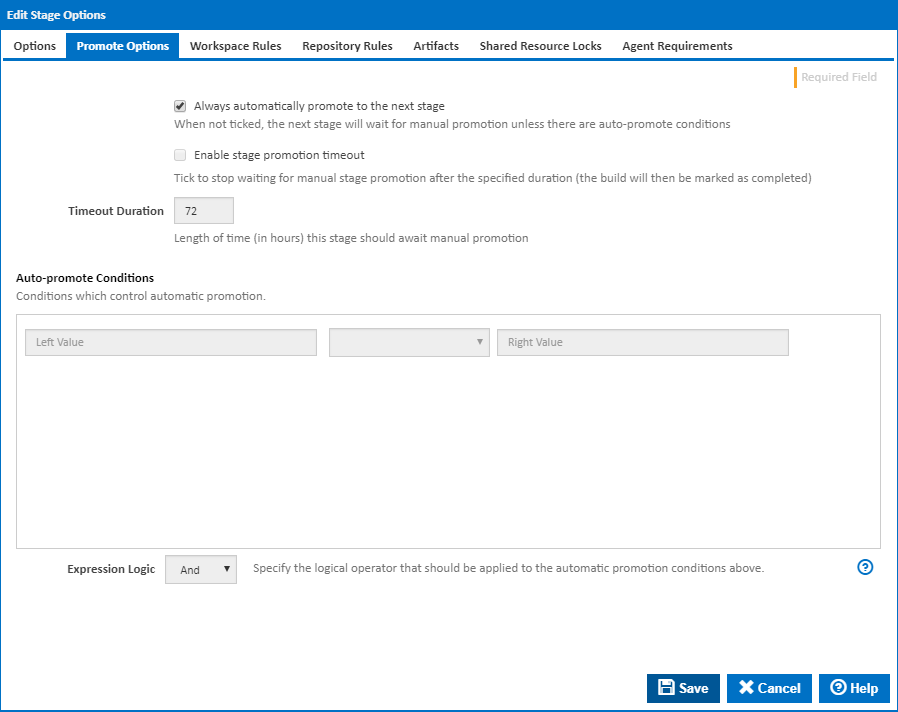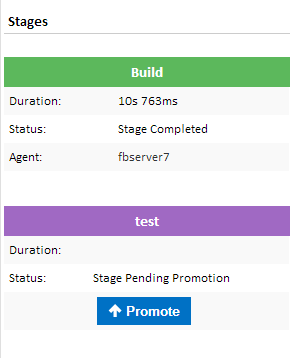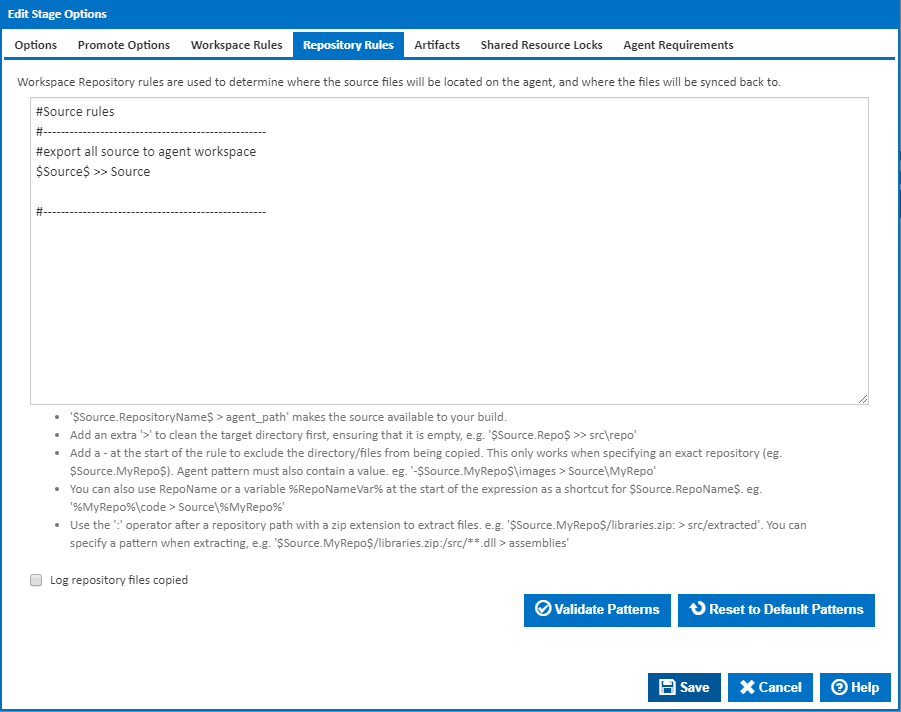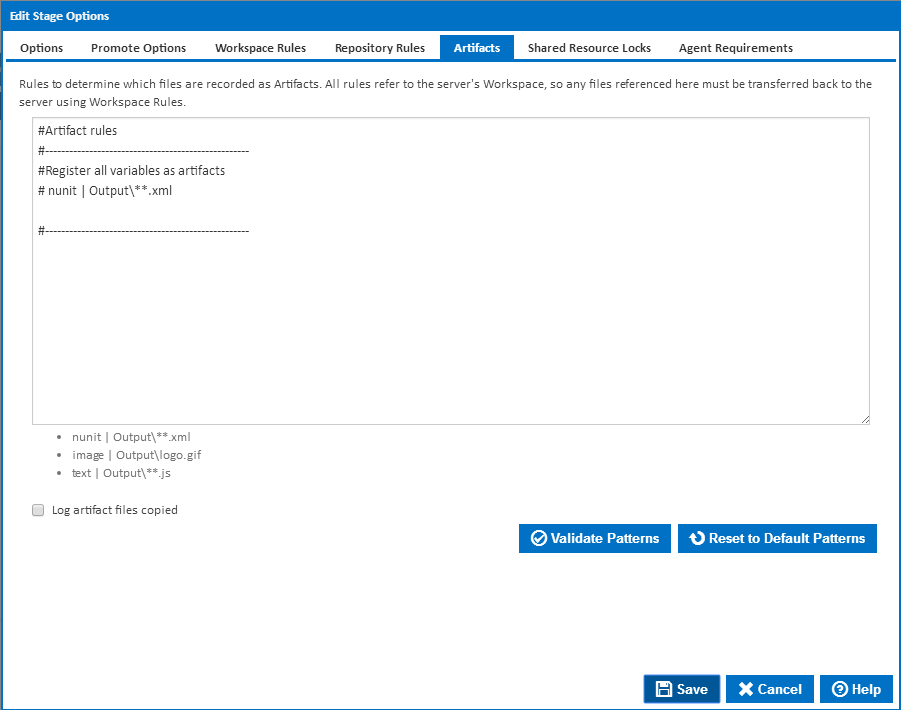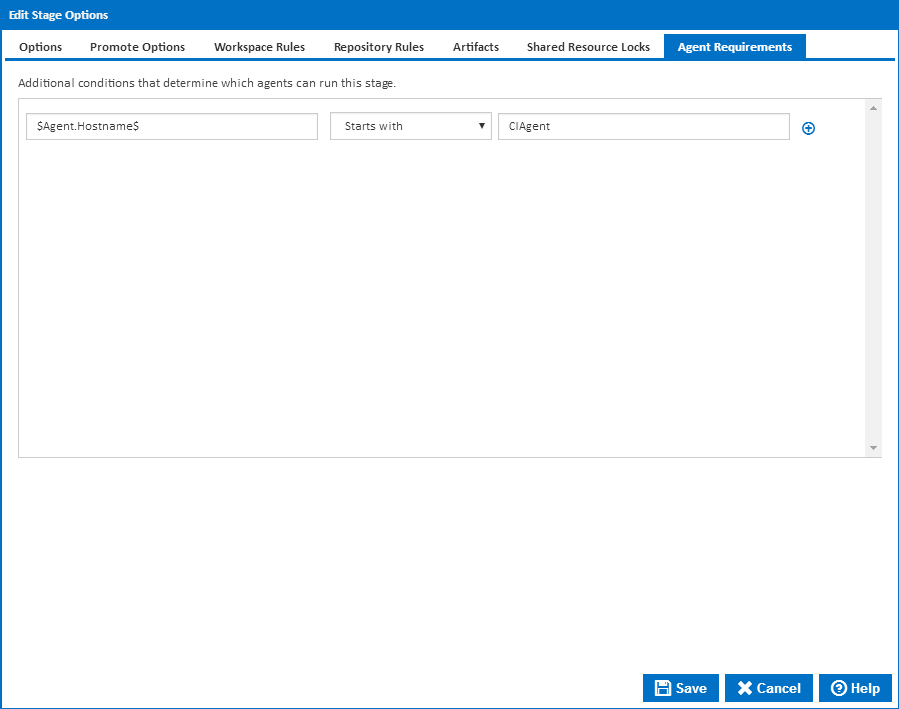...
Stage options can be accessed by double clicking on a stage arrow from the 'Stages' workflow section. A dialog showing options for the respective stage will be displayed:
Stage Options
Name
The name of the stage
Enabled
Should the stage be considered when running a build.
Skip Conditions
Conditions which result in this stage being skipped. Expressions can be used here to build up a set of conditions. Note that multiple conditions are joined together with a logical AND - as a result, if any of the lines evaluate to false, the respective stage will be run
Expression Logic
Specify the logical operator that should be applied to the automatic promotion conditions above.
| Anchor | ||||
|---|---|---|---|---|
|
Always automatically promote to the next stage
Determines if this stage should be automatically promoted once it has completed executing, or if it should await manual promotion.
Once a stage has completed, the options on this tab determine whether the build automatically continues onto the next stage. If this option is not ticked the 'Auto-promote conditions' come into effect to determine if the build should continue. Please note that the Auto-promote Conditions are joined together with a logical AND. As a result, if any of the lines evaluate to false, the stage status will be set to 'Stage Pending Promotion'.
Enable stage promotion timeout
Determines how long a the build should wait for promotion to the next stage. If this is ticked then the build will be marked as completed once the Timeout Duration is reached. This will allow the build to be cleaned up, but will prevent the build from being promoted.
Timeout Duration
Length of time (in hours) this stage should await manual promotion.
Auto-Promote Conditions
Conditions which control automatic promotion.
Expression Logic
Specify the logical operator that should be applied to the automatic promotion conditions above.
Clicking on the Promote button will trigger the next stage.
...
Scenarios and examples of workspace exclude rules can be found on the Workspace Rules page.
Repository Rules
Log workspace files copied
Write the file name of each file copied to the Build Log.
Repository Rules
A repository rule is used to get files out of the repositories attached to the Configuration and into the agent's workspace. Repository rules look and function similar to workspace rules but have a few extra constraints.
...
When a build starts and the workspace is initially created on the server, the contents of that build's workspace contain no trace of any repositories. Instead, the server will process the repository rules and determine which repositories need to be synced to the agent. The agent will then take note of those repositories and update its repository cache. The agent then runs the repository rules against the repository in its repository cache. This eliminates the need for the server to deal with any copying of repositories. It also has the advantage of making subsequent builds a lot quicker. Instead of having to copy the repository from the server to the agent for each build, the agent simply does a local copy from its repository cache into the workspace directory.
Log repository files copied
Write the file name of each file copied to the Build Log.
Artifacts
What are Artifacts?
...
Scenarios and examples of registering can be found on the Artifact Rules page.
Log workspace files copied
Write the file name of each file copied to the Build Log.
Shared Resource Locks
| Info |
|---|
Note that Shared Resource Locks are available from version 1.8 |
...
See Defining Shared Resource Locks for more details on editing Stage Shared Resource Locks.
Agent Requirements
Agent requirements are a set of conditions that must be met before the stage will execute on a particular agent. In addition to using variables as condition values, you can also use the $Agent$ descriptor which gives you access to agent details like hostname, port and all property collector values. Note that these conditions give you fine grain control over the configuration and stages. It's possible to make the entire Configuration execute on a single agent, but having agent requirements allows you to force one stage to run on a specific agent while letting Continua decide which is the best agent to run the other stages on. If the rules are left blank then Continua CI will determine which agent should run that stage.
...
- You have a trigger set up to execute every day at 3 in the morning. It executes a Configuration which is set up to take a copy of your main repository, archive it and send it to your backup server. The backup server also happens to act as a Continua CI agent and you want to take advantage of that, By using the backup server agent, the backup archive file will be created in the build's workspace on the backup server agent, then it's just a matter of copying that file from the build's workspace, into a directory on the backup server that handles backing files up. If you were to use an agent that wasn't the backup server then the copying of the archive file to the backup server would happen over the network. This is an ideal situation for an agent condition that forces a stage to run on a specific agent. To do this, you would reference the agent's hostname by using the descriptor $Agent.Hostname$ then select Equals from the drop down list and put the name of the agent in the right hand side input field.
- You've created a program or script that automates a whole lot of functionality like creating installers for your application, uploading them to a FTP server and sending out emails to your users. When you integrate it into Continua CI, you simply create a stage which has an Execute Program Action which executes your script. Because your script is creating installers, uploading files using FTP and sending out emails, your script needs to be executed on an agent that has your installer creator application, the ftp client and email application installed. To ensure the build runs on an agent with all three of those applications installed you would setup agent conditions for the stage that runs your script. First you would setup Property Collectors for each of the applications, all they would do is check if an executable exists (eg. MyFtpClient.exe) in the given path. Once they're setup, you can create an agent condition that checks for the existence of that application. You would first choose the Exist option from the drop down menu then use a descriptor like $Agent.MyFTPClient.Path$. This would force the build to only execute on an agent which has that path on it.
- You can select the agent you want a build or stage executed on when you start the build. Create a Configuration Variable called AgentToRunOn for example and make it a prompt type of Text. By doing this, every time you manually start a build, it will ask you what Text value you would like to provide to the AgentToRunOn variable. When setting up your agent conditions on a stage, you would use the $Agent.Hostname$ descriptor for the left value, select Equals from the drop down list and type %AgentToRunOn% for the right value. By doing this, you allow the user to type in which agent they want a stage run on every time a build is manually started. You could make it more secure by changing the variable to be a Selection prompt type and supply a list of agents that can be used. You would of course need to create specific permissions for editing variables and allow only admins to edit variables.
Agent Priority
The “Agent Priority” field determines the sequence in which agents with equal capacity are chosen to execute a particular stage. This field should contain a property that is unique to each agent.
By default, new stages will include the expression $Agent.Priority.Value$, which refers to an agent property collector. This collector defines a numerical "Priority.Value" property for each agent, with a default value of 0. To assign priority to an agent for this stage, modify the ‘Priority.Value’ property for that agent. If you need to set a different priority for a stage or group of stages, consider adding a new agent property collector.
The priority expression can evaluate to either a number or a string:
- If it’s a number, agents with higher numbers are prioritized.
- If it’s a string, agents are ordered alphabetically, with “A” selected before “Z”.
You can reverse this order by selecting the “Select agent in reverse order of priority” option.
| Info |
|---|
| Please note that agent selection is primarily based on capacity, which is calculated by subtracting the number of running stages from the Concurrent Stage Limit. For instance, if two agents have a concurrent stage limit of 2 and one stage is running on Agent A while no stages are running on Agent B, Agent B will be chosen to run the stage regardless of the agent priority value. However, you can override this by selecting the “Priority overrides capacity” option. With this setting enabled, an available agent with a higher priority value will be selected first, regardless of how many stages are currently running on it. |

